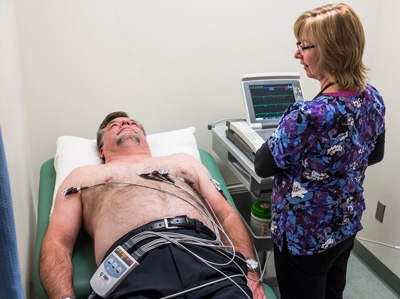Purpose

An electrocardiogram (ECG) is a simple and painless test that measures and records the electrical activity of your heart.
The main job of your heart is to pump blood throughout your body. The pumping of your heart is regulated by an electrical current or impulse. With each heartbeat, the impulse spreads through the top to the bottom chambers of your heart causing the muscle fibres to contract and squeeze blood out to the rest of your body.
Many heart conditions including arrhythmias, cardiomyopathy, congenital heart defects, coronary artery disease, heart valve disease, and heart attack can cause changes or disruptions in the electrical activity of your heart.
An ECG is a diagnostic test that your doctor may recommend if you are experiencing abnormal heart beats or if you are having chest pain.
Description

The test is performed in the ECG clinic located on the second floor of the Heart Institute.
- You will be asked to remove your jewellery and to put on a hospital gown.
- The ECG technician will explain the procedure to you.
- The technician will apply small sticky pads (electrodes) to several spots on your chest, arms, and legs. These electrodes are then connected to the ECG machine.
- The technician will ask you to lie still for about five minutes. The electrodes will detect the electrical activity of your heart and the results will be recorded and printed on graph paper. You will not feel anything while this is happening.
- The results are reviewed by a cardiologist and a report is sent to your doctor who will discuss the results with you.
Patient instructions
You do not need to restrict what you eat or drink before this test, but it is recommended that you not smoke just before the test.
Additional info
When you come to the Heart Institute, please check in with central registration in the front lobby. Then proceed to the second floor. Turn to the left when you exit the elevators. If you take the stairs to the second floor, turn right at the top of the stairs, then turn left at the elevators. Please note renovations are still underway at this time. Directions will change periodically. Please ask for directions from the registration clerk or one of our volunteers wearing red vests. They will be pleased to help you get to where you are going.
An ECG is not harmful in any way. Rarely, a patient may develop a temporary rash or swelling at the electrode sites.
A standard ECG will record only those electrical problems in the heart that are continuous. To record problems that only occur only sometimes, a patient may need to use a Holter monitor.

